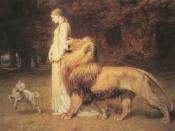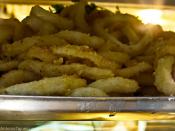Lust in Edmund Spenser's The Fairie Queene According to the Oxford dictionary, to lust means "to have strong sexual desire"� (Oxford, 529). Edmund Spenser's epic poem The Fairie Queen is a allegory about a Red Crosse Knight (holiness) and his maiden Una (truth), who are sent on a journey to conquer a dragon (sin), and their many struggles along the way. The struggle that will be analysed and depicted in this essay, will be the attempted rape of Una (a symbol of truth) by Sansloy, an evil Sarazin, in the deep and wild forest. The episode takes place over 6 stanzas, beginning in (I.VI.iii.1) and ending in (I.VI.viii.9). The Allegorical writing of Spenser is carefully engineered to include subtle, yet extremely important meanings that are not included in the narrative writing itself. His extremely confining method of writing is considered amazing by standards during the Renaissance period through to today's writings.
This essay will touch upon the episode of lust, the themes and ideas within the episode, a short paraphrase of the, the imagery, symbolism and poetic/syntactic language, along how and where Spenser intertwines and ties in other episode to the episode of lust.
The episode takes place in the deep and wild forest. The episode begins with Una and Sansloy returning from a battle in which Sansloy defeated Archimago (I.VI.iii.1). As Sansloy admires Una's beauty and pureness, he is overcome by a "wrathfull fire to lustfull heat"�(I.VI.iii.3). The episode continues for another 6 stanzas until a flock of Faunes and Satyres come running to the sound of Una's desperate cry, and scare off the raging Sansloy (I.VI.viii.9). Although the episode is a relatively short one, it contains many important themes and ideas. The main themes, are of lust and the attack of a raging Sansloy (who represents evil without...


